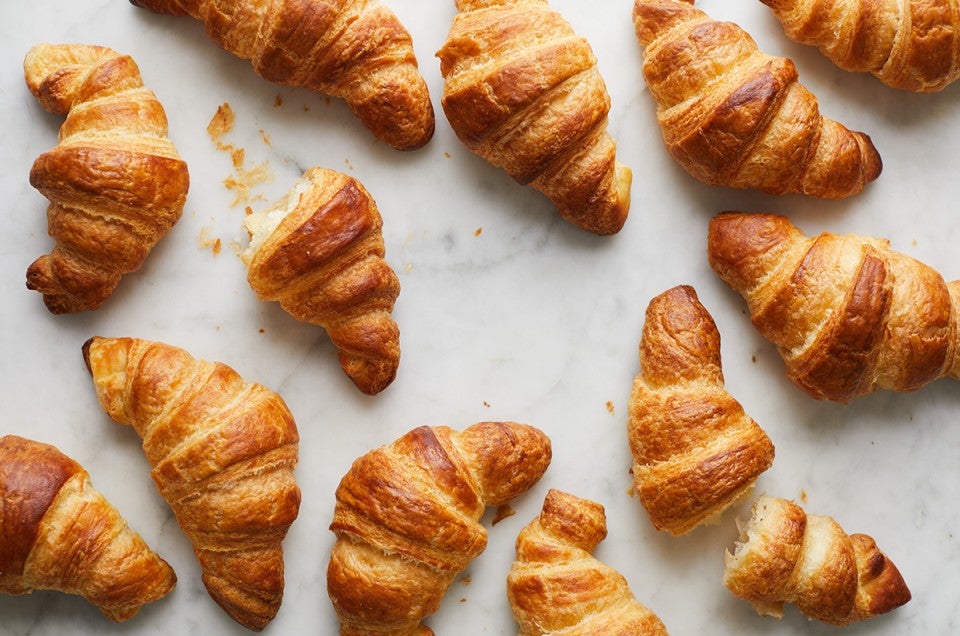



Want to take your holiday baking to new heights? The Holiday 2018 issue of Sift magazine features lots of special-occasion recipes. And no baking adventure is more impressive than creating the light, shatteringly delicate layers found in buttery croissants.
If you've ever wondered how to make croissants, we're happy to share our step-by-step sequence for assembling this dough. Croissants are made from puff pastry, which isn't difficult; it needs only a bit of patience. Paying attention to small details makes a big difference when you pull the fragrant, buttery results from the oven. These are the key points for executing amazing puff pastry from scratch.
If you want to know how to make croissants, you need to begin with lamination. That's the technique of enclosing a pliable slab of butter inside dough, then rolling and folding it to create pastry's layered texture.

First, let's pick our recipe. We're going use the classic Baker's Croissants. The dough is made with yeast and, once mixed, is patted into a 12" square. No kneading is necessary, since the rolling and folding you're about to do takes its place.
After mixing the butter with a little flour to soften and stabilize it, it too is shaped into a square and placed "on point" in the center of the dough, like a diamond in a square. Take care with neat corners and straight lines; it will make a big difference in the finished product.
Bring the corners of the dough to the center over the butter, and pinch the seams together to completely surround it. Dust the top with flour and turn the packet over.

Tap the dough lightly with a rolling pin, encouraging it into a rectangular shape. Roll it into a 20" x 10" rectangle. Fold the bottom third of the dough to the center of the rectangle, and the top third over that. Take care to line the edges up over one another.

Turn the dough 90°, so it looks like a book ready to be opened. Tack down the corners with a little water if the layers slide around. Roll and fold the dough once more, same as you did the first time.
At this point, the dough will be ready to cover and rest for 30 minutes in the refrigerator. This timeout will allow the butter to firm up, and the gluten in the dough to relax. The last fold will be much easier afterward.

After resting the dough, give it one more rollout and fold. See how nicely the dough is shaping up? Once the last fold is executed, chill the dough for 20 to 30 minutes before dividing it in half.

Cut the dough in half, and wrap and chill the remainder (you can freeze it for later for up to a month if you like). The cross-section above shows off the many distinct layers of dough and butter, ready to be rolled, cut, shaped, and baked.

Roll your half batch of dough into a 13" x 18" rectangle. Use a pastry wheel to trim 1/4" to 1/2" of the dough's outer edges before cutting into portions. Trimming the edges allows the dough to rise higher during baking. Save the trimmings and roll with sugar to make a quick morning bun.
Now cut the dough in thirds top to bottom, and in half across the center. Then cut each rectangle into two triangles, as shown above.

Cut a 3/4" notch in the base of the croissant's dough triangle; this allows you to curve it as you roll it up. Make sure the point of the dough ends up underneath each croissant. Hint: It's OK to stretch the point of the triangle a little to make the end land where you want it.

For square-shaped filled croissants, roll and cut the dough as described above, but leave the dough in six rectangles.
Place the filling in the center of the rectangle with the long side facing you; we're using pain au chocolat sticks in the photo above. Fold one side of the dough over the filling, then roll the croissant over to put the seam on the bottom. Press it down gently to flatten it before transferring it to the baking sheet.

After letting croissants rise and brushing with egg wash, they'll bake up into something as lovely as these Spinach Croissants.
Learning how to make croissant dough is immensely satisfying; once the dough is done, you have the chance to make all sorts of pastry magic. Whether plain, savory, or chocolate-filled, warm, fresh croissants are not to be missed.
Tender and sweet morning buns are the a wonderful of treat, and any pastry tray is made more intriguing with some Tahini Chocolate Bear Claws.

A little time, care, and technique can turn flour and butter into the best kind of occasion. We hope you'll make use of this tutorial on how to make croissants to turn out your own brilliant pastries for your lucky family and friends.
For more recipes, techniques, and pastry perfection, check out the Holiday 2018 issue of Sift magazine.

